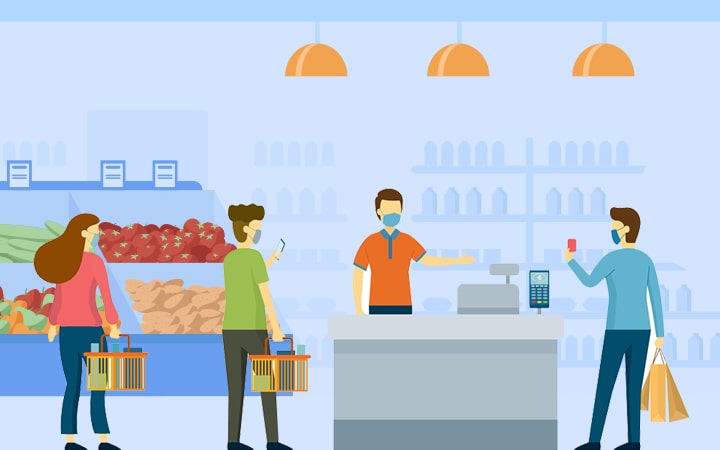3 Trends that Prove the Future of Retail is Contactless Payments

Contactless payment refers to the financial services based on mobile communication networks and Internet technologies that mobile operators provide to mobile users through mobile phones with contactless communication functions, mainly on-site payment services.
As the name implies, there is no need for cash or card swiping. You can complete the transaction by simply bringing the mobile phone close to the card reader. Benefits of contactless payments in Retail eliminates the cumbersome process of entering a password and signing when swiping a card, avoids the hassle of waiting for change when paying in cash, and has a huge impact on traditional payment methods.
Mobile phone manufacturers integrate contactless cards into mobile phones, not only to make the payment process more convenient, but also to add more financial service functions as needed.
Developing Trends of Contactless Payments in the Future of Retail
Application field expansion trend
After recent years of development, the non-contact payment has involved more than a dozen fields such as urban public transportation, retail, and petroleum. At the same time, contactless payment technology has also begun to be used in non-payment fields, such as identification, access control, etc.
With the regional economic integration development, contactless cards have emerged across town use trends, such as Shanghai public transportation “card” may have been in Wuxi, Suzhou, Hangzhou and other cities GM, the Yangtze River Delta residents to bring travel convenience.
It is expected that by 2010, 16 member cities in the Yangtze River Delta region will realize transportation card interoperability.
With the continuous expansion of the application field of contactless payment cards, a prominent problem is the massive increase in the number of personal cards. Take Shanghai as an example. As of November 2007, Shanghai alone has developed 12 types of contactless payment cards, including gas cards, bus cards, and retail payment cards. While these cards provide convenience, they also bring various inconveniences.
Therefore, the integration of various cards is imperative. The future development direction of contactless payment is to integrate the bus card, gas card and other cards of different purposes into one card to realize one card with multiple uses.
The “City One Card” currently being promoted and constructed in some cities is a manifestation of one card with multiple uses. By then, residents only need to hold one card to enjoy fast and efficient services in various aspects such as finance, social insurance, and transportation, and truly realize the “one card”. In hand, life is worry-free.” It can be said that one card with multiple uses is an inevitable trend in the development of contactless payment in the future of retail as well.
Tool selection trend
At present, the carrier of contactless payment technology in China is mainly based on card base. Due to the continuous expansion of the function of the “retail & city card”, the technology has become more mature, and it has been involved in the field of identification.
In the future, card base will be used as contactless It is difficult to fundamentally change the situation of payment carriers. At the same time, the privacy, portability and simplicity of mobile phones make them a natural and excellent physical carrier of non-contact mobile payments.
With the popularization of mobile phones and the development of new mobile services in the 3G era, mobile phones are bound to show their talents in the field of contactless payment in the future. As a result, in terms of contactless payment for retail, card-based payment and mobile payment will coexist, and this situation will continue for a long time.
According to a survey conducted by consulting company AC Nielsen in China in 2006, more than 80% of consumers want to integrate payment tools such as bus cards and bank cards into their mobile phones. At the end of 2007, there were more than 500 million mobile phone users in my country.
The research company Analysys International predicts that the size of my country’s mobile payment market will reach 1.974 billion yuan in 2009. With the promotion of the NFC test project, the contactless payment business will become a rapid growth point of my country’s mobile phone application services.
In order to promote the development of electronic payment, China Mobile and Bank of China have jointly established UMF Technology Company to cope with this rapidly developing market. At present, electronic payment mainly includes two methods : Internet + PC payment and communication network + mobile payment.
Non-contact payment is becoming a more important mobile electronic payment method. Now, UMF has 20 million individual users. These users have about 150,000-200,000 transactions per day, each with an amount of about 100 yuan.
The number of mobile electronic payment users in China is expected to reach 100 million by 2010, and it will reach more than 200 million in the future. The vigorous development of electronic payment provides important conditions for the development of contactless mobile payment.
The combination of mobile phones and contactless technology will surely form a huge market in the future. You can hire a dedicated development team to develop an e-wallet app that serves all contactless payment methods.
Trend of the integrity of the industrial chain
Regarding the commercial deployment of contactless payment technology applications, the most important and complex issue is to establish an ecosystem in which all parties can share benefits.
From the analysis of business growth laws, the development and prosperity of an industry requires accurate positioning, reasonable division of labor and optimal allocation of resources in each link in the industry chain. Only by establishing and continuously improving the industrial chain, contactless payment business can develop healthily, and each link in the industrial chain can achieve a win-win situation in cooperation.
Contactless payment is an open market with many links in the value chain, including: mobile operators, commercial banks, third-party payment service providers (third-party mobile payment platform operators), chip manufacturers, mobile phone manufacturers, and equipment.
There are multiple links such as terminal providers, merchants and mobile phone users, among which the main participants are mobile operators, commercial banks and third-party payment service providers (third-party mobile payment platform operators).
At present, my country’s contactless payment business is still in the early stage of development, and the industrial chain has not yet formed stably. But judging from the current situation, almost all links in the industrial chain have surfaced. And related parties actively participate in promoting the development of contactless payment applications, creating favorable conditions for contactless payment from a small-scale pilot to a large-scale deployment.
Author Bio
Nikunj Gundaniya, Product manager Digipay.guru, one of the leading fintech solution providers USA, which provides mobile finance application development services. He is a visionary leader whose flamboyant management style has given profitable results for the company. He believes in the mantra of giving 100% to his work.






